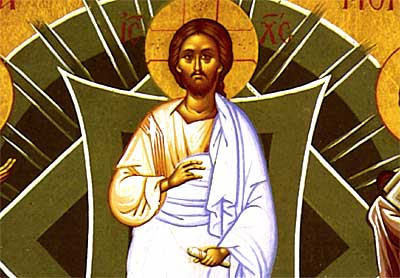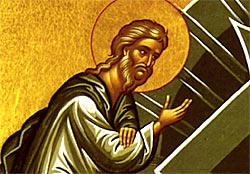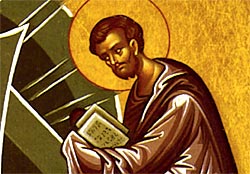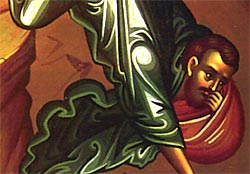This is a great feast day in the Catholic and Orthodox Church.
Icon of the Feast
 |
In the icon of the Feast of the Transfiguration, Christ is the
central figure (1.), appearing in a dominant position within a circular
mandorla. He is clearly at the visual and theological center of the
icon. His right hand is raised in blessing, and his left hand contains a
scroll. The mandorla with its brilliant colors of white, gold, and blue
represent the divine glory and light. The halo around the head of
Christ is inscribed with the Greek words O on, meaning "The One Who is".

1. Christ appears in the center of the icon blessing with His right hand and dressed in bright white robes (detail).
Elijah (2.) and Moses (3.) stand at the top of separate mountain peaks to the left and right of Christ. They are bowing toward Christ with their right hands raised in a gesture of intercession towards Him. Saint John Chrysostom explains the presence of these two fathers of the faith from the Old Testament in three ways. He states that they represent the Law and the Prophets (Moses received the Law from God, and Elijah was a great prophet); they both experienced visions of God (Moses on Mount Sinai and Elijah on Mount Carmel); and they represent the living and the dead (Elijah, the living, because he was taken up into heaven by a chariot of fire, and Moses, the dead, because he did experience death).

2. The Prophet Elijah, appears on Christ's right-hand side (detail).

3. Moses, who is seen holding the Ten Commandments, appears on Christ's left-hand side (detail).
Below Christ are the three Apostles, who by their posture in the icon show their response to the transfiguration of Christ (4.). James has fallen over backwards with his hands over his eyes. John in the center has fallen prostrate. Peter is kneeling and raises his right hand toward Christ in a gesture expressing his desire to build the three booths. The garments of the Apostles are in a state of disarray as to indicate the dramatic impact the vision has had on them.

4. The three Apostles who accompanied Christ to the moutain, Peter, John, and James, react to the vision of Christ's Transfiguration.

5. The garments of the Apostles are in state of disarray (detail).

6. The Apostle James reacts to the vision by falling to the ground and attempting to cover his eyes (detail).
The icon of the feast directs our attention toward the event of the
Transfiguration and specifically to the glory of God as revealed in
Christ. This event came at a critical point in the ministry of our Lord,
just as He was setting out on His journey to Jerusalem. He would soon
experience the humiliation, suffering, and death of the Cross.
Another tradition says the Jesus as he spoke to Moses and Elijah was telling them to prepare the place of the dead, like John the Baptist did on earth for His coming. The place of the dead is also known as Sheol, or Limbo of the Father's, also called Abraham's Bosom. This is the place the righteous of the Old Testament waited for the Gates of Heaven to be opened by Christ.
Scripture refers to Jesus descending to the realm of the dead and
preaching to the dead (Eph. 4:9; 1 Pet. 3:18-20). What did Jesus preach
to them? Jesus preached to those who were to enter heaven. He would open the Gates of heaven and lead them in.
No comments:
Post a Comment